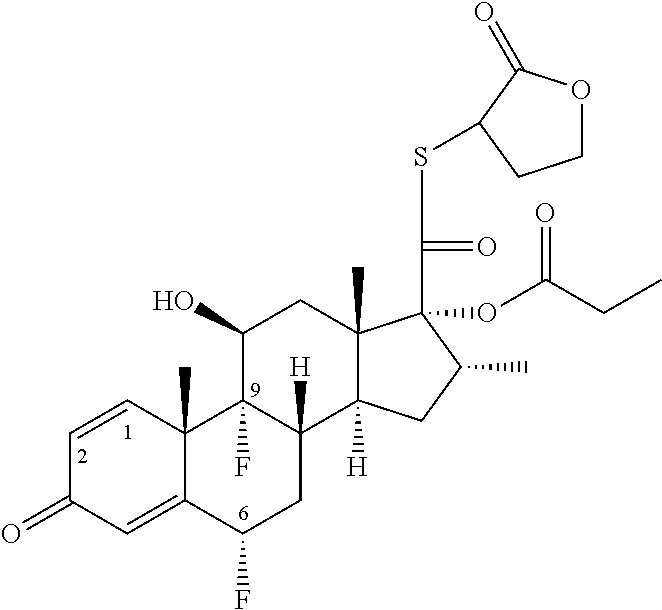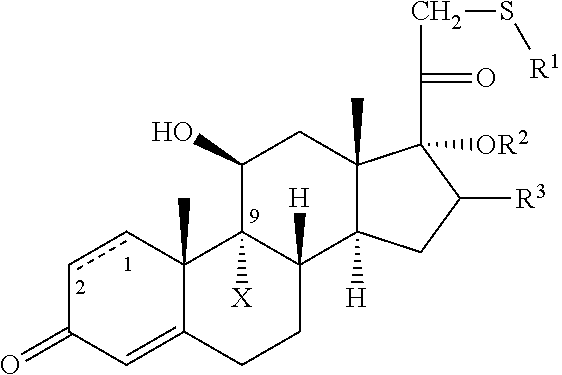C21 thioethers as glucocorticoid receptor agonists
a technology of glucocorticoid receptor and thioether, which is applied in the direction of aerosol delivery, immunological disorders, drug compositions, etc., can solve the problems of limiting the dose of drugs that may be administered to the patient or the time period, reducing the safety profile at higher doses, and reducing the liability of systemic glucocorticoid. , the effect of reducing the propensity
- Summary
- Abstract
- Description
- Claims
- Application Information
AI Technical Summary
Benefits of technology
Problems solved by technology
Method used
Image
Examples
example 1
Step 1
[0230]
[0231]A solution of the hydrocortisone 11 (5 g, 0.0138 mol) in dichloromethane (100 mL) was treated with diisopropylethylamine (8.9 g, 0.0691 mol) at 0° C. The reaction mixture was allowed to stir for 5 minutes; methane sulfonyl chloride (2.9 g, 0.02486 mol) was added drop wise at 0° C. and allowed to stir for 4-6 hours. The reaction mixture was diluted with dichloromethane, taken in to a separatory funnel and washed with dilute HCl, water, brine and dried over anhydrous sodium sulfate. Removal of the solvent gave the crude mesylate, which was purified by using column chromatography using dichloromethane and methanol (20:1) to afford the mesylate 12 as a crystalline solid. Yield=5.5 g (82%).
Step 2
[0232]
[0233]To a solution of the hydrocortisone-21-mesylate 12 (10 g, 0.0227 mol) in dichloromethane was added diisopropylethyamine (14.65 g, 0.114 mol) dropwise at 0° C. The reaction mixture was then treated with the 2-mercaptobenzothiazole (5.69 g, 0.0341 mol) and stirring was...
example 2
[0234]
[0235]The title compound was prepared from desonide 21 in two steps using procedures of Example 1, except that potassium carbonate in acetone at reflux was used in the second step in place of diisopropylethyamine in dichloromethane. The reaction mixture was cooled to room temperature, filtered and the filtrate was concentrated to give the crude product. The crude Product was purified by column chromatography. MH+566
[0236]The compounds shown in Table I are non-limiting examples of compounds of the invention which were synthesized using the procedures described herein (or procedures analogous thereto).
TABLE 1Table 1: StructureM + H512496454580507577577580530510455459464495457456527509518490456524494446566461478523591524523625614564541573573565593591524541469521521508468483469457525493507468473551569535472535443516554517535535543508502563510549537503529521555521521521471487474507524483469551564577469525563591591625607598529524577564558591610557561595528573513586524563516537558525...
PUM
| Property | Measurement | Unit |
|---|---|---|
| temperature | aaaaa | aaaaa |
| concentration | aaaaa | aaaaa |
| particle sizes | aaaaa | aaaaa |
Abstract
Description
Claims
Application Information
 Login to View More
Login to View More - R&D
- Intellectual Property
- Life Sciences
- Materials
- Tech Scout
- Unparalleled Data Quality
- Higher Quality Content
- 60% Fewer Hallucinations
Browse by: Latest US Patents, China's latest patents, Technical Efficacy Thesaurus, Application Domain, Technology Topic, Popular Technical Reports.
© 2025 PatSnap. All rights reserved.Legal|Privacy policy|Modern Slavery Act Transparency Statement|Sitemap|About US| Contact US: help@patsnap.com



